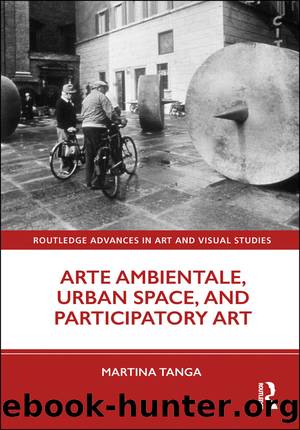Arte Ambientale, Urban Space, and Participatory Art by Martina Tanga

Author:Martina Tanga
Language: eng
Format: epub
Publisher: Taylor and Francis
4
Riappropriazione Dellâambiente
Ugo La Pietraâs and Franco Summaâs Urban Interventions
In a photograph from Ugo La Pietraâs archive, republished in the book Abitare la città in 2011, the artist sits on a bench with two colleaguesâLivio Marzot and Giuseppe Spagnuloâobserving the construction of high-rise residential buildings in Milanâs periphery [Figure 4.1]. Directly in front of them lies a narrow patch of grass with a few newly planted trees. This seems to be the only green spaceâand social spaceâleft in this vicinity. Beyond are soaring residential towers in various states of construction. A lattice of scaffolding and massive cranes dominates the horizon. Nothing about this part of the image is at human scale, nor do we see any people; only endless rows of apartment towers. This view exemplifies the state of Milanâs peripheries during the 1970s. La Pietra witnessed the outsized growth of his hometown as its residential outskirts expanded like an oozing dark oil stain. Throughout the peripheries of Italyâs major cities like Rome, Turin, and Naples, grids of high-rises emerged without logical connection to how people lived and what they needed to build a community. These areas served one purpose: shelter for those who could not afford to live in ballooning urban centers.
For artists like La Pietra, the city needed to be won back from capitalist and commoditizing forces, and reappropriation became an aesthetic strategy. He worked with local inhabitants or alone to reformulate and recast urban and suburban spaces. Curator Enrico Crispolti highlighted this phenomenon in the section âIndividual Urban Reappropriationâ at the 1976 Venice Biennale exhibition Ambiente come Sociale, calling attention to the work of La Pietra and Franco Summa as particularly representative of this trend. Their activity ranged from photographic observation to transformative interventions, such as painting marks on a building and mounting performance activities in the streets. Critically, they situated all these aesthetic projects within the fabric of the city, taking up space both physically and figuratively. La Pietra and Summa repurposed the city as both a site of protest and a space of illumination, ultimately hoping to make inhabitants aware of their surroundings and the latent discourses of power in their communities.
This chapter takes La Pietraâs and Summaâs art practices as case studies, elaborating on aesthetic interventions in the urban context already addressed in Crispoltiâs exhibitions, specifically Volterra â73 and Ambiente come Sociale, and in the work of sculptors such as Somaini and Staccioli. This section, however, will focus on La Pietraâs and Summaâs architectural, painterly, photographic, and conceptual strategies of reappropriating urban space. Delving into these artistsâ oeuvre during these years, I examine the intersection of their aesthetic activity and sociopolitical movements concerned with taking back the urban environment.
Figure 4.1 Ugo La Pietra, Periferia di Milano, durante la ricerca sui âGradi di Libertà ,â c. 1970, documentary photograph.
Download
This site does not store any files on its server. We only index and link to content provided by other sites. Please contact the content providers to delete copyright contents if any and email us, we'll remove relevant links or contents immediately.
Technical Art History by Jehane Ragai(443)
Art, Science, and the Natural World in the Ancient Mediterranean, 300 BC to AD 100 by JOSHUA J. THOMAS(399)
Graphic Culture by Lerner Jillian;(391)
The Slavic Myths by Noah Charney(360)
Pollak's Arm by Hans von Trotha(331)
Simply Artificial Intelligence by Dorling Kindersley(330)
Treasuring the Gaze by Hanneke Grootenboer(330)
Sketchbook Confidential: Secrets from the private sketches of over 40 master artists by Editors of North Light Books(326)
The Art of Portrait Drawing by Cuong i(324)
Drawing for the Soul by Zoë Ingram(318)
Drawing Landscapes by Barrington Barber(312)
The Art of Painting Sea Life in Watercolor by Maury Aaseng Hailey E. Herrera Louise De Masi and Ronald Pratt(301)
Mountain Manâs Field Guide to Grammar by Gary Spina(299)
Portrait of a Woman by Bridget Quinn(288)
Anatomy for the Artist by Jennifer Crouch(280)
A text-book of the history of painting by Van Dyke John Charles 1856-1932(280)
Preparing Dinosaurs by Wylie Caitlin Donahue;(274)
Botanical Illustration by Valerie Price(271)
Egyptian art by Jean Capart(267)
